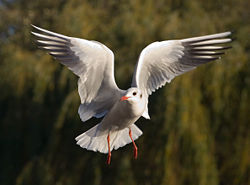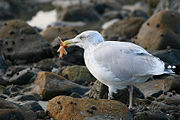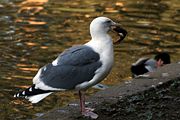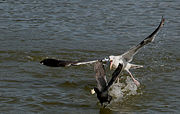Gull
| Gulls | ||||||||||||
|---|---|---|---|---|---|---|---|---|---|---|---|---|
 Black-headed Gull
|
||||||||||||
| Scientific classification | ||||||||||||
|
||||||||||||
| Genera | ||||||||||||
|
Larus |
Gulls (often informally Seagulls) are birds in the family Laridae. They are most closely related to the terns (family Sternidae) and only distantly related to auks, and skimmers, and more distantly to the waders. Until recently, most gulls were placed in the genus Larus, but this arrangement is now known to be polyphyletic, leading to the resurrection of several genera.[1]
They are typically medium to large birds, usually grey or white, often with black markings on the head or wings. They typically have harsh wailing or squawking calls. They have stout, longish bills, and webbed feet. Gull species range in size from the Little Gull, at 120 g (4.2 oz) and 29 cm (11.5 inches), to the Great Black-backed Gull, at 1.75 kg (3.8 lbs) and 76 cm (30 inches).
Contents |
Biology and habits
Most gulls, particularly Larus species, are ground nesting carnivores, which will take live food or scavenge opportunistically. The live food often includes crabs and small fish. Apart from the kittiwakes, gulls are typically coastal or inland species, rarely venturing far out to sea and into surrounding deciduous forests. The large species take up to four years to attain full adult plumage, but two years is typical for small gulls. Large White-Headed Gulls are typically long-lived birds, with a maximum age of 49 years recorded for the Herring Gull.[2]
Gulls nest in large, densely packed, and noisy colonies. They lay two to three speckled eggs in nests composed of vegetation. The young are precocial, being born with dark mottled down, and mobile from birth[3].
Gulls—the larger species in particular—are resourceful, inquisitive and highly intelligent birds, demonstrating complex methods of communication and a highly developed social structure; for example, many gull colonies display mobbing behaviour, attacking and harassing would-be predators and other intruders.[4] In addition, certain species (e.g. the Herring Gull) have exhibited tool use behaviour. Many species of gull have learned to coexist successfully with humans and have thrived in human habitats. Others rely on kleptoparasitism to get their food. The urban gull population in the United Kingdom has been growing quickly, probably due to laws such as the Clean Air Act 1956 which prohibited the burning of garbage by local landfill owners, thus increasing the availability of food for the gulls.[5][6]
Taxonomy
The taxonomy of gulls is confused by their widespread distribution and geneflow leading to zones of hybridization. Some have traditionally been considered ring species, but recent evidence suggest this assumption is questionable.[7] Until recently, most gulls were placed in the genus Larus, but this arrangement is now known to be polyphyletic, leading to the resurrection of the genera Ichthyaetus, Chroicocephalus, Leucophaeus, Saundersilarus and Hydrocoloeus.[1] Some English names refer to species complexes within the group:
- Large white-headed gull is used to describe the 18 or so Herring Gull-like species from California Gull to Lesser Black-backed Gull in the taxonomic list below.
- White-winged gull is used to describe the 4 pale-winged, High Arctic-breeding taxa within the former group; these are Iceland Gull, Glaucous Gull, Thayer's Gull, and Kumlien's Gull.
Hybridisation between species of gull occurs quite frequently, although to varying degrees depending on the species involved (see Hybridisation in gulls). The taxonomy of the large white-headed gulls is particularly complicated.
In common usage, members of various gull species are often referred to as sea gulls or seagulls. This name is used by the layman to refer to a common local species or all gulls in general, and has no fixed taxonomic meaning.
The American Ornithologists' Union combines Sternidae, Stercorariidae, and Rhynchopidae as subfamilies in the family Laridae, but recent research [8][9][10] indicates that this is incorrect.
List of species
This is a list of gull species, presented in taxonomic sequence.





Genus Larus
- Pacific Gull, Larus pacificus
- Belcher's Gull, Larus belcheri
- Olrog's Gull, Larus atlanticus
- Black-tailed Gull, Larus crassirostris
- Heermann's Gull, Larus heermanni
- Common Gull or Mew Gull, Larus canus
- Ring-billed Gull, Larus delawarensis
- California Gull, Larus californicus
- Great Black-backed Gull, Larus marinus
- Kelp Gull, Larus dominicanus (called "Southern Black-backed Gull" or "Karoro" in New Zealand)
- Cape Gull, Larus dominicanus vetula
- Glaucous-winged Gull, Larus glaucescens
- Western Gull, Larus occidentalis
- Yellow-footed Gull, Larus livens
- Glaucous Gull, Larus hyperboreus
- Iceland Gull, Larus glaucoides
- Kumlien's Gull, Larus glaucoides kumlieni
- Thayer's Gull, Larus thayeri
- Herring Gull, Larus argentatus
- Heuglin's Gull, Larus heuglini
- American Herring Gull, Larus smithsonianus
- Yellow-legged Gull, Larus michahellis
- Caspian Gull, Larus cachinnans
- East Siberian Herring Gull, Larus vegae
- Armenian Gull, Larus armenicus
- Slaty-backed Gull, Larus schistisagus
- Lesser Black-backed Gull, Larus fuscus
- Saunders' Gull, Larus saundersi
Genus Ichthyaetus
- White-eyed Gull, Ichthyaetus leucophthalmus
- Sooty Gull, Ichthyaetus hemprichii
- Great Black-headed Gull, Ichthyaetus ichthyaetus
- Audouin's Gull, Ichthyaetus audouinii
- Mediterranean Gull, Ichthyaetus melanocephalus
- Relict Gull, Ichthyaetus relictus
Genus Leucophaeus
- Dolphin Gull, Leucophaeus scoresbii
- Laughing Gull, Leucophaeus atricilla
- Franklin's Gull, Leucophaeus pipixcan
- Lava Gull, Leucophaeus fuliginosus
- Gray Gull, Leucophaeus modestus
Genus Chroicocephalus
- Silver Gull, Chroicocephalus novaehollandiae
- Red-billed Gull, Chroicocephalus scopulinus
- Hartlaub's Gull, Chroicocephalus hartlaubii
- Brown-hooded Gull, Chroicocephalus maculipennis
- Gray-hooded Gull, Chroicocephalus cirrocephalus
- Andean Gull, Chroicocephalus serranus
- Black-billed Gull, Chroicocephalus bulleri
- Brown-headed Gull, Chroicocephalus brunnicephalus
- Black-headed Gull, Chroicocephalus ridibundus
- Slender-billed Gull, Chroicocephalus genei
- Bonaparte's Gull, Chroicocephalus philadelphia
Genus Saundersilarus
- Saunders' Gull, Saundersilarus saundersi
Genus Hydrocoloeus
- Little Gull, Hydrocoloeus minutus
Genus Rhodostethia
- Ross's Gull, Rhodostethia rosea
Genus Rissa
- Black-legged Kittiwake, Rissa tridactyla
- Red-legged Kittiwake, Rissa brevirostris
Genus Pagophila
- Ivory Gull, Pagophila eburnea
Genus Xema
- Sabine's Gull, Xema sabini
Genus Creagrus
- Swallow-tailed Gull, Creagrus furcatus
Evolution
The Laridae are known from fossil evidence since the Early Oligocene, some 30-33 mya. A fossil gull from the Middle to Late Miocene of Cherry County, USA is placed in the prehistoric genus Gaviota; apart from this and the undescribed Early Oligocene fossil, all prehistoric species were tentatively assigned to the modern genus Larus. Among those of them that have been confirmed as gulls, "Larus" elegans and "L." totanoides from the Late Oligocene/Early Miocene of southeast France have since been separated in Laricola.
Gallery
References
- ↑ 1.0 1.1 Pons J.-M. ; Hassanin A. ; Crochet P.-A.(2005) Phylogenetic relationships within the Laridae (Charadriiformes: Aves) inferred from mitochondrial markers. Molecular phylogenetics and evolution 37(3):686-699.
- ↑ "AnAge entry for Larus argentatus". The Animal Ageing and Longevity Database. Retrieved on 2008-11-23.
- ↑ Harrison, Colin J.O. (1991). Forshaw, Joseph. ed.. Encyclopaedia of Animals: Birds. London: Merehurst Press. pp. 109-111. ISBN 1-85391-186-0.
- ↑ Alcock, J. (1998) Animal Behavior: An Evolutionary Approach (7th edition). Sinauer Associates, Inc. Sunderland, Massachusetts. ISBN 0-87893-009-4
- ↑ http://www.ehj-online.com/archive/2000/may2003/may1.html
- ↑ http://www.birdnomore.com/gulls.htm
- ↑ Liebers, Dorit; de Knijff, Peter & Helbig, Andreas J. (2004): The herring gull complex is not a ring species. Proc Biol Sci. 271(1542): 893-901.
- ↑ Paton, Tara A. & Baker, Allan J. (2006): Sequences from 14 mitochondrial genes provide a well-supported phylogeny of the Charadriiform birds congruent with the nuclear RAG-1 tree. Molecular Phylogenetics and Evolution 39(3): 657–667. doi:10.1016/j.ympev.2006.01.011 (HTML abstract)
- ↑ Paton, T. A.; Baker, A. J.; Groth, J. G. & Barrowclough, G. F. (2003): RAG-1 sequences resolve phylogenetic relationships within charadriiform birds. Molecular Phylogenetics and Evolution 29: 268-278. doi:10.1016/S1055-7903(03)00098-8 (HTML abstract)
- ↑ Thomas, Gavin H.; Wills, Matthew A. & Székely, Tamás (2004): A supertree approach to shorebird phylogeny. BMC Evol. Biol. 4: 28. doi:10.1186/1471-2148-4-28 PDF fulltext Supplementary Material
Bibliography
- Grant, Peter J. (1986) Gulls: a guide to identification ISBN 0-85661-044-5
- Howell, Steve N. G. and Jon Dunn (2007) Gulls of the Americas ISBN 0-618-72641-1
- Olsen, Klaus Malling & Larsson, Hans (1995): Terns of Europe and North America. Christopher Helm, London. ISBN 0-7136-4056-1
External links
- Rudy's Gull-index Pictures of less well-known plumages of large gulls
- Gull videos on the Internet Bird Collection
- Gullpix Pictures of gulls, sorted by species